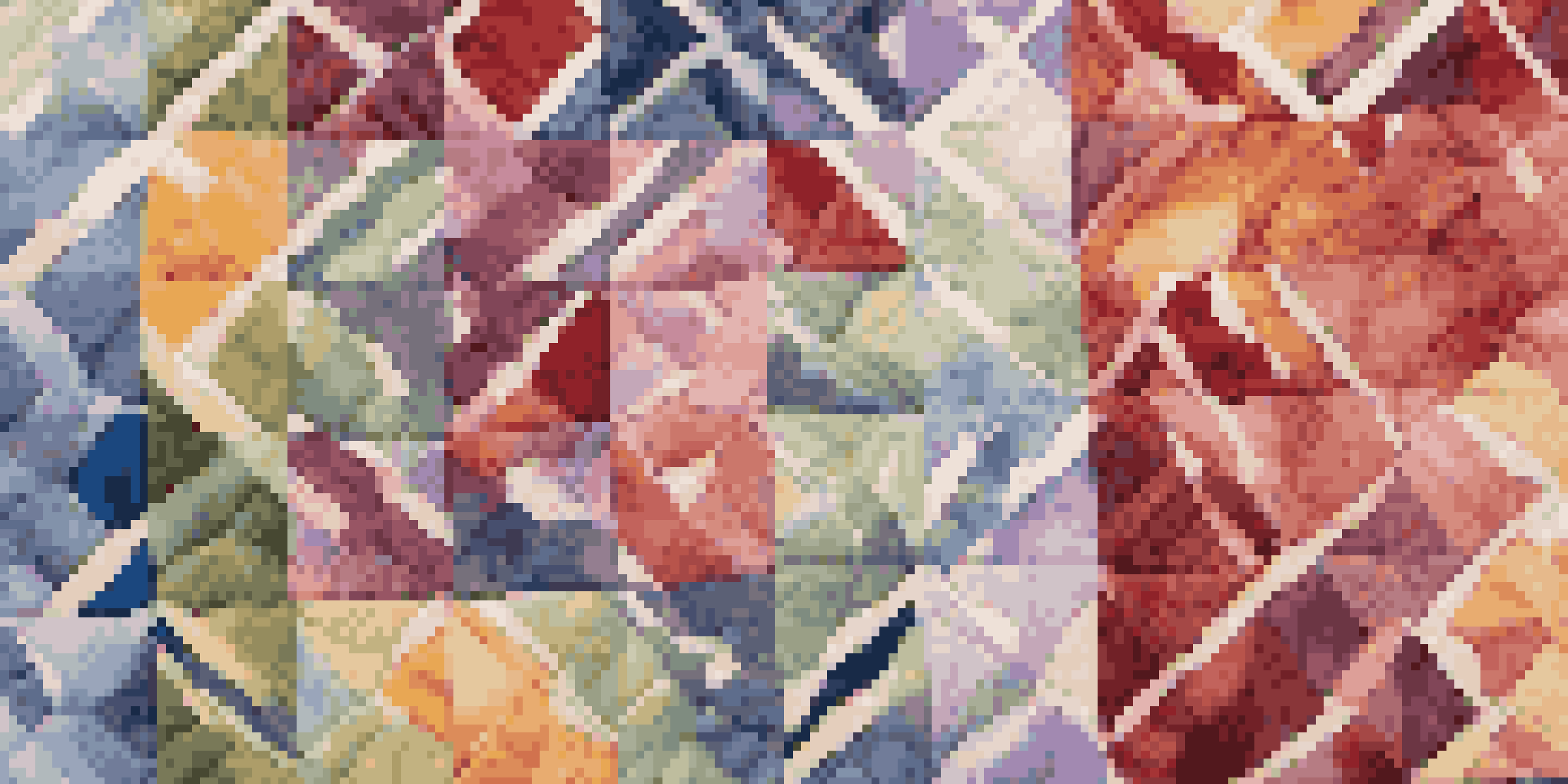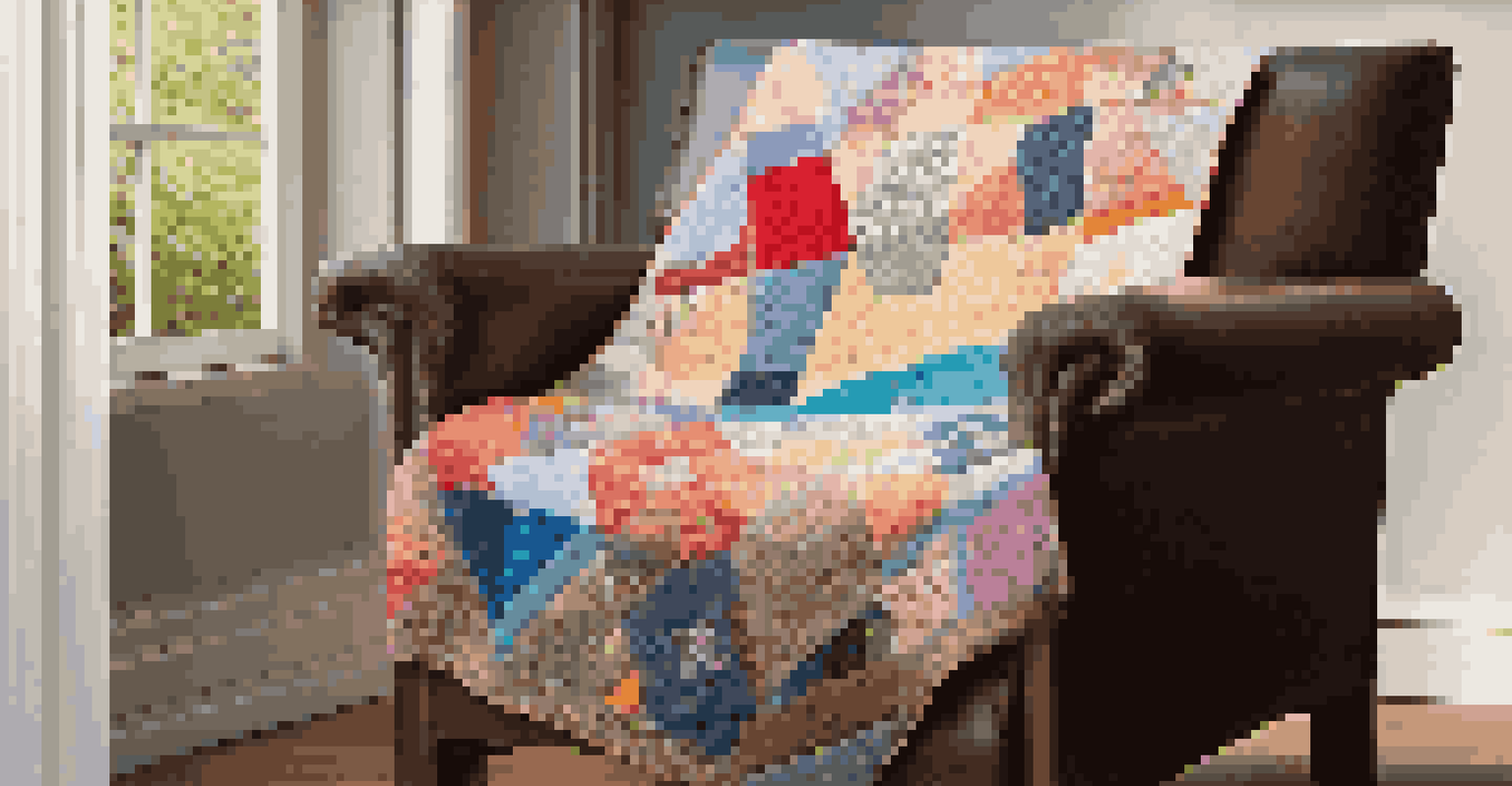How to Bind a Quilt: Techniques for a Finished Look

Understanding Quilt Binding: The Basics You Need to Know
Quilt binding is the final touch that brings your quilt together, both functionally and aesthetically. It’s like the frame around a beautiful painting—it enhances the overall look and provides a finished edge. Understanding the basics of binding is crucial for any quilter aiming for a polished finish.
A quilt is a treasure that follows its owner everywhere.
There are several types of quilt binding, but the most common is single-fold and double-fold binding. Single-fold binding is simpler and often used for smaller projects, while double-fold binding offers more durability and a neater appearance. Knowing which type to use can significantly impact the final look of your quilt.
Always remember that binding not only secures the edges but also adds a decorative element. Choosing the right fabric can complement your quilt's design and even highlight certain colors. A good binding can elevate your quilt from ordinary to extraordinary.
Selecting the Right Fabric for Binding Your Quilt
Choosing the right fabric for your quilt binding is key to achieving a cohesive look. Consider using the same fabric that’s in your quilt’s border or a solid color that ties in with the quilt's color palette. This helps create a seamless transition and enhances the overall design.

However, don’t be afraid to experiment! A contrasting fabric can provide an eye-catching pop that draws attention. Think of it as accessorizing an outfit—sometimes a bold choice can really make things stand out and feel more personalized.
Quilt Binding Enhances Aesthetics
Binding not only secures the edges of your quilt but also adds a decorative element that can elevate its overall appearance.
When selecting fabric, also consider the weight and texture. A lightweight cotton is often preferred as it folds easily and lays flat, while heavier fabrics may add bulk. Your choice can affect both the appearance and the durability of your quilt, so choose wisely!
Preparing Your Quilt for Binding: Key Steps to Follow
Before you can bind your quilt, it’s essential to prepare the edges properly. Start by trimming any excess batting or backing to ensure that everything is even. This prevents any awkward bumps or folds in the finished product and sets you up for success.
Creativity is allowing yourself to make mistakes. Design is knowing which ones to keep.
Next, press the edges of your quilt to remove any wrinkles. A smooth surface will make it easier to attach the binding and will result in a cleaner finish. Think of it like ironing a shirt before wearing it—those little details make a big difference!
Finally, measure the perimeter of your quilt and cut your binding strips accordingly. A common rule of thumb is to cut the strips about 2.5 inches wide, but you can adjust this based on your preferences. Having everything prepped will make the binding process much smoother.
Cutting and Preparing Binding Strips: A Step-by-Step Guide
To cut your binding strips, start by laying your fabric flat and cutting along the grain. This helps to ensure that the fabric has the right amount of stretch and won’t distort when you sew it. Using a rotary cutter and mat can make this task easier and more precise.
Once cut, the next step is to sew the strips together. You can do this using a diagonal seam which creates a smoother finish when binding. Picture it like connecting the dots—it's a simple but effective technique that can make your quilt look much more professional.
Choosing the Right Binding Fabric
Selecting fabric that complements your quilt's design is crucial for a cohesive look, whether you stick with matching colors or opt for a bold contrast.
After sewing the strips, trim the seams to reduce bulk and press them open. This small step is often overlooked but can greatly enhance the way the binding lays on your quilt. A well-prepared binding will make all the difference in the final presentation.
Attaching Binding to Your Quilt: Techniques for Success
Attaching the binding to your quilt is both an art and a science. Start by aligning the raw edges of the binding with the quilt top, using clips or pins to hold it in place. This step is crucial because it ensures that everything stays secure while you sew, preventing any shifting.
When you begin sewing, use a quarter-inch seam allowance for a clean finish. This may feel a bit daunting at first, but with practice, it will become second nature. Think of it as tracing a line—precision is key to achieving the desired outcome.
As you approach the corners, remember to miter them for a polished look. This involves folding the binding at a 45-degree angle, creating a neat corner that enhances your quilt's overall appearance. It’s those little details that can really make your quilt stand out!
Finishing Techniques: Hand-Stitching vs. Machine-Stitching
Once the binding is attached, you have a choice to make: finish it by hand or machine. Hand-stitching gives a soft, traditional finish that many quilters love, while machine-stitching is quicker and provides a more secure hold. Each method has its own charm, so choose based on the look you want to achieve.
If you opt for hand-stitching, use a blind stitch for an almost invisible finish. This technique involves catching only a few threads on the quilt back, which can create a beautiful, clean edge. It’s a bit time-consuming but can be incredibly rewarding.
Techniques for Attaching Binding
Proper techniques, such as aligning edges and mitering corners, are vital for achieving a polished and professional finish on your quilt.
On the other hand, machine-stitching is perfect for those who want to finish their quilts quickly. Just make sure to use a stitch that complements your binding fabric. Whichever method you choose, be proud of your work—the finish is what truly brings your quilt to life!
Final Touches: Preparing Your Quilt for Display or Use
With the binding complete, it’s time for those final touches. Give your quilt a good press to remove any creases from the binding process. This step can elevate the overall look, making your quilt appear fresh and brand new.
Consider adding a label to your quilt. This personal touch not only signifies your hard work but also makes it a cherished keepsake. It’s like signing your artwork—your quilt deserves recognition for the love and effort you’ve put into it.

Finally, whether you're displaying your quilt or gifting it, take a moment to admire your handiwork. Binding a quilt is not just about finishing; it’s about celebrating your creativity and craftsmanship. Enjoy the satisfaction of a job well done!